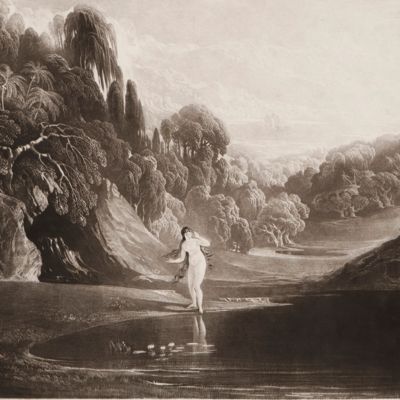Martin, J. [and J. Milton]
Paradise lost. Eve at the Fountain. Large(st) mezzotint plate from the large-size edition.
London, Septimus Prowett, [1824]-1827. Oblong folio (36.6 x 52.4 cm). Mezzotint plate (printed surface 25.8 x 35.5 cm).
A magnificent proof-plate from the very rare folio edition with much larger sheets than those in the "usual" quarto editions (of which the largest was ca. 27 x 37 cm), and with the plates in the larger of two states (both sets separately engraved by Martin). This wonderfully detailed plate with Rembrandtesque light and shadows, illustrates Milton's Book 4, line 453. Eve at the Fountain. John Martin (1789-1854) was an English Romantic painter, engraver and illustrator. He was celebrated for his typically vast and melodramatic paintings of religious subjects and fantastic compositions, populated with minute figures placed in imposing landscapes. Martin's paintings, and the prints made from them, enjoyed great success with the general public - in 1821 Thomas Lawrence referred to him as "the most popular painter of his day...Martin began to experiment with mezzotint technology, and as a result was commissioned to produce 24 engravings for a new edition of Paradise Lost - perhaps the definitive illustrations of Milton’s masterpiece" (Wikipedia). "The poem concerns the biblical story of the Fall of Man: the temptation of Adam and Eve by the fallen angel Satan and their expulsion from the Garden of Eden. Milton's purpose, stated in Book I, is to "justify the ways of God to men." (Wikipedia). Part of the original, corresponding text by Milton neatly written in an old hand below the printed caption. Light, mostly marginal foxing or spotting, otherwise in very good condition. Bénézit 5, p. 807-808; Thieme/Becker 24, pp. 159-160.




